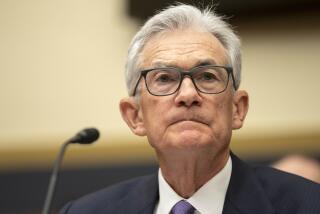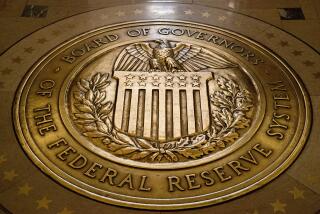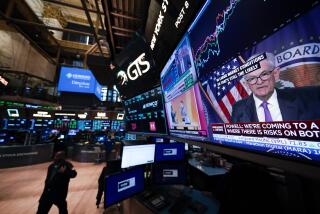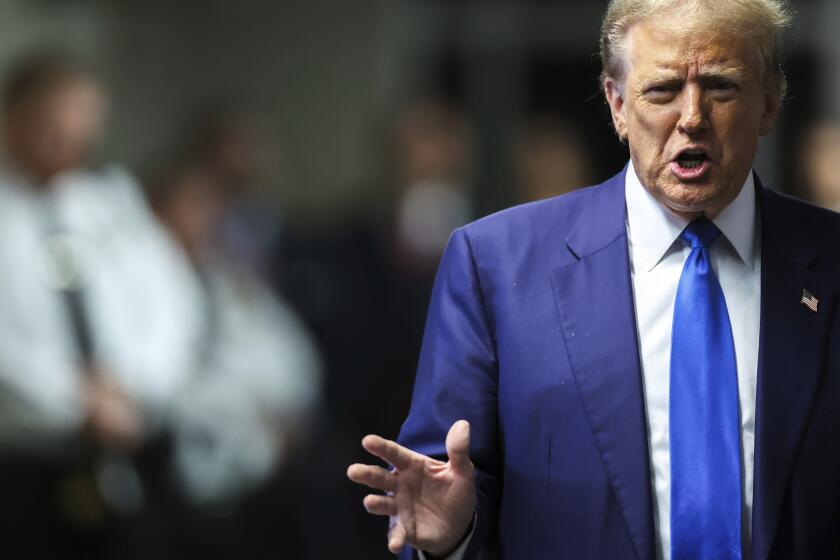Trump steps up pressure on Fed to cut interest rates, but economists say it’s a bad idea

President Trump is heaping nonstop pressure on the Federal Reserve to lower interest rates and provide further support to speed up growth, even though the economy is expanding at a healthy pace and economists widely agree that this is not the time to be taking such actions.
As Fed officials were huddled in their two-day meeting that began Tuesday, a mile away in the White House, Trump fired off his latest tweet criticizing the institution. The president said the Fed should cut interest rates by a full percentage point, double what he had previously wanted, and also called on the Fed to inject the kind of unconventional bond-buying stimulus that was used to fight the Great Recession.
In his tweet, Trump said that although “China is adding great stimulus to its economy while at the same time keeping interest rates low,” the Fed “has incessantly lifted interest rates even though inflation is very low.”
The Fed, after raising rates four times last year, hit the brakes at the start of this year. And at the conclusion of their meeting Wednesday, Fed officials are widely expected to announce they will leave their benchmark interest rate unchanged at 2.25% to 2.5%, and signal that it will stay at that level for some time.
Trump, in comparing the Fed with the Chinese central bank, looked past the fact that the People’s Bank of China is controlled by an authoritarian central government that tightly manages the economy. The century-old Fed operates independently in a market economy, and its ability to make decisions without political interference is fiercely guarded by Fed officials and many lawmakers as foundational for effective policymaking.
“When there’s a lot of political pressure, then you usually see higher inflation and often slower growth,” said Lee Ohanian, a UCLA economics professor, referring to the experience of central banks in other countries.
By U.S. historical standards, the current level of interest rates is low, but Trump and his economic advisors have been relentless in castigating the Fed for last year’s rate hikes and demanding that it reverse those actions. Among them is the conservative commentator Stephen Moore, whom the president plans to nominate for a seat on the Fed board.
Last week, Herman Cain, a former pizza chain executive whom Trump also wanted to place on the Fed’s seven-member board, bowed out amid concerns he could not be confirmed.
Moore said Tuesday that he remained hopeful of being formally nominated, but his confirmation may also be in question because of his past writings and statements on gender issues, including complaints about equal pay for women and women’s role in sports.
Trump already has filled four of the seven Fed board seats, although none was seen as a staunch Trump loyalist. Trump’s pick for the Fed chair, Jerome H. Powell, has come under repeated attack from the president for the rate increases. And Trump reportedly considered firing Powell, although it isn’t clear that the president has the authority to do so as Congress has oversight of the Fed.
Powell and his colleagues last year stepped up interest rate increases to guard against the risks of rising inflation amid strong economic growth and a tight labor market. They also wanted to lift interest rates back up to a level closer to 3% or a bit higher, to give them greater latitude to lower rates and stimulate borrowing and investment in the event of a recession.
The Fed halted its rate hike campaign after stock markets languished, in part because of Fed actions but also because of the U.S.-China trade war and slowing global growth. In addition, inflation lately has been unexpectedly low, a possible sign of underlying weakness in demand.
Powell has defended the Fed’s actions and often spoken about the independence of the central bank. At the same time, he has been careful not to criticize Trump or comment on the president’s potential nominees for the Fed board.
Presidents have rarely made public criticisms of the Fed. But impolitic as Trump’s comments have been, economists say that his views are simply off base because there’s little economic justification for demanding lower rates and additional stimulus.
“I don’t think it’s useful at the moment because we’re in a very tight labor market situation,” said Alice Rivlin, a former Fed vice chair and longtime Brookings Institution scholar. “So why would you want to cut rates?”
Diane Swonk, chief economist at accounting and advisory firm Grant Thornton, said it makes sense for the Fed to stand pat on rates until it sees more clearly what’s happening with growth and inflation.
Lowering interest rates now, she said, could put the economy at greater risk down the road, causing asset bubbles by making borrowing too easy and cheap. Already, she said, the economy has lofty valuations of certain stocks and commercial real estate as well as too much corporate debt, especially rising use of junk bonds.
“You want growth, but you don’t want growth at a price,” Swonk said.
Trump hasn’t expressed concerns about such potential costs — and as he looks ahead at the 2020 election, he isn’t likely to let up on urging the Fed to stimulate the economy.
“We have the potential to go up like a rocket if we did some lowering of rates, like one point, and some quantitative easing,” Trump tweeted Tuesday, using the Fed term for the crisis-era bond-buying stimulus. “Yes, we are doing very well at 3.2% GDP, but with our wonderfully low inflation, we could be setting major records &, at the same time, make our National Debt start to look small!”
The first quarter’s 3.2% growth in gross domestic product, or economic output, came after the economy expanded at almost 3% for all of last year. By most economists’ thinking, such growth rates already were well above the U.S. economic growth potential of around 2%, based on productivity and labor force trends.
Trump has spurred economic activity in part through the massive tax cut bill that passed in late 2017, but that also has added significantly to the federal deficit and its stimulative effects on the economy are starting to wane.
For most of the Fed’s history it has cut interest rates only when policymakers think the economy is sliding into recession, said Chris Rupkey, chief economist at MUFG Union Bank in New York. And although there were such concerns earlier in the year, the outlook for the Chinese and global economies has since improved.
Meanwhile, U.S. job growth has been resilient and consumer spending appears to be picking up, quieting fears of a near-term recession.
But that’s still not likely to be enough for the president. “One thing we know from Trump is he’s not going to back down,” Rupkey said of Trump’s tweets and comments pushing the Fed to cut rates. Trump will want to do whatever he can to pump up the economy, Rupkey added, and should there be a downturn, the focus on the Fed will make a convenient culprit.
“The president’s cleverly laid the groundwork for putting the blame at the Federal Reserve,” he said.
More to Read
Get the L.A. Times Politics newsletter
Deeply reported insights into legislation, politics and policy from Sacramento, Washington and beyond. In your inbox three times per week.
You may occasionally receive promotional content from the Los Angeles Times.







